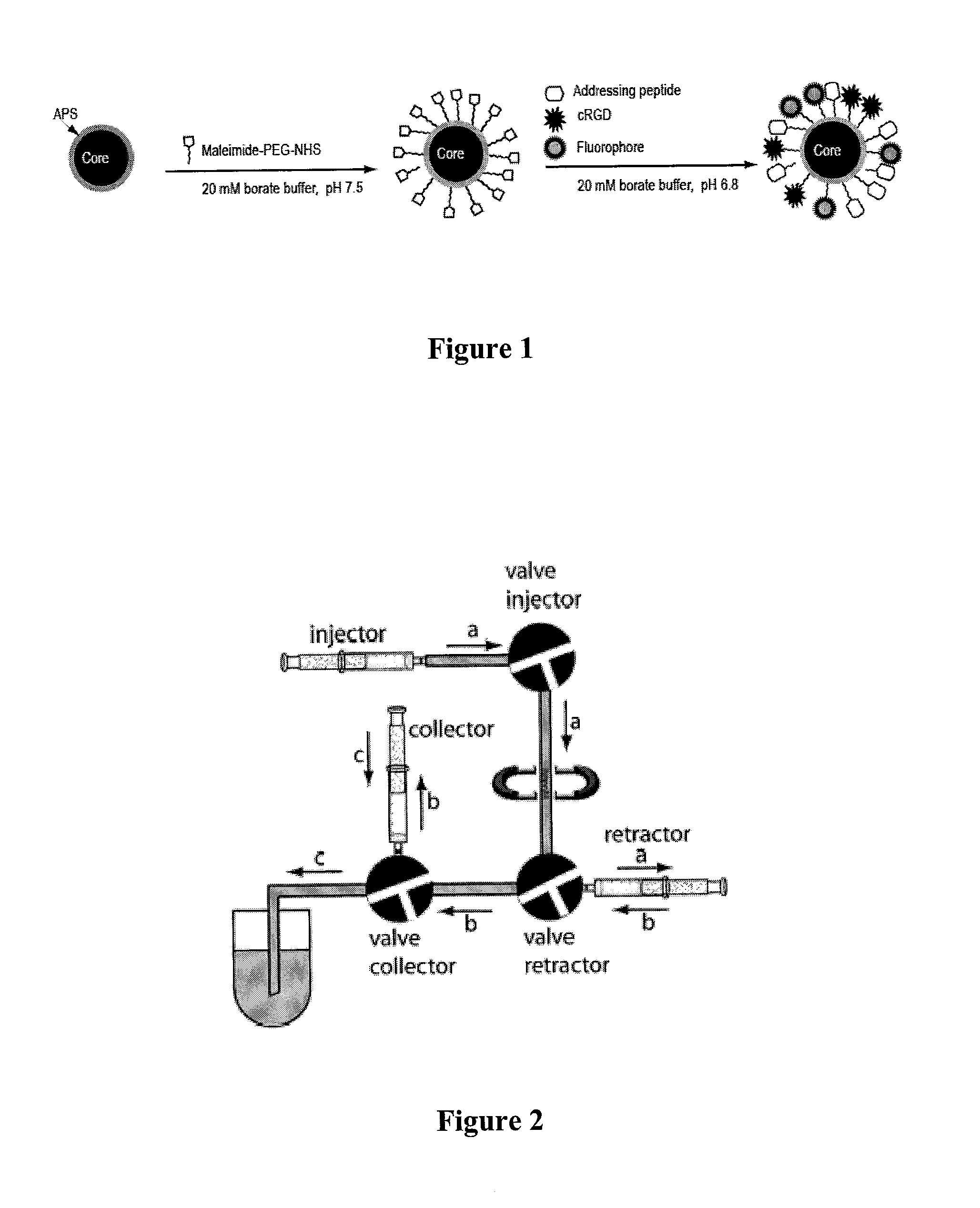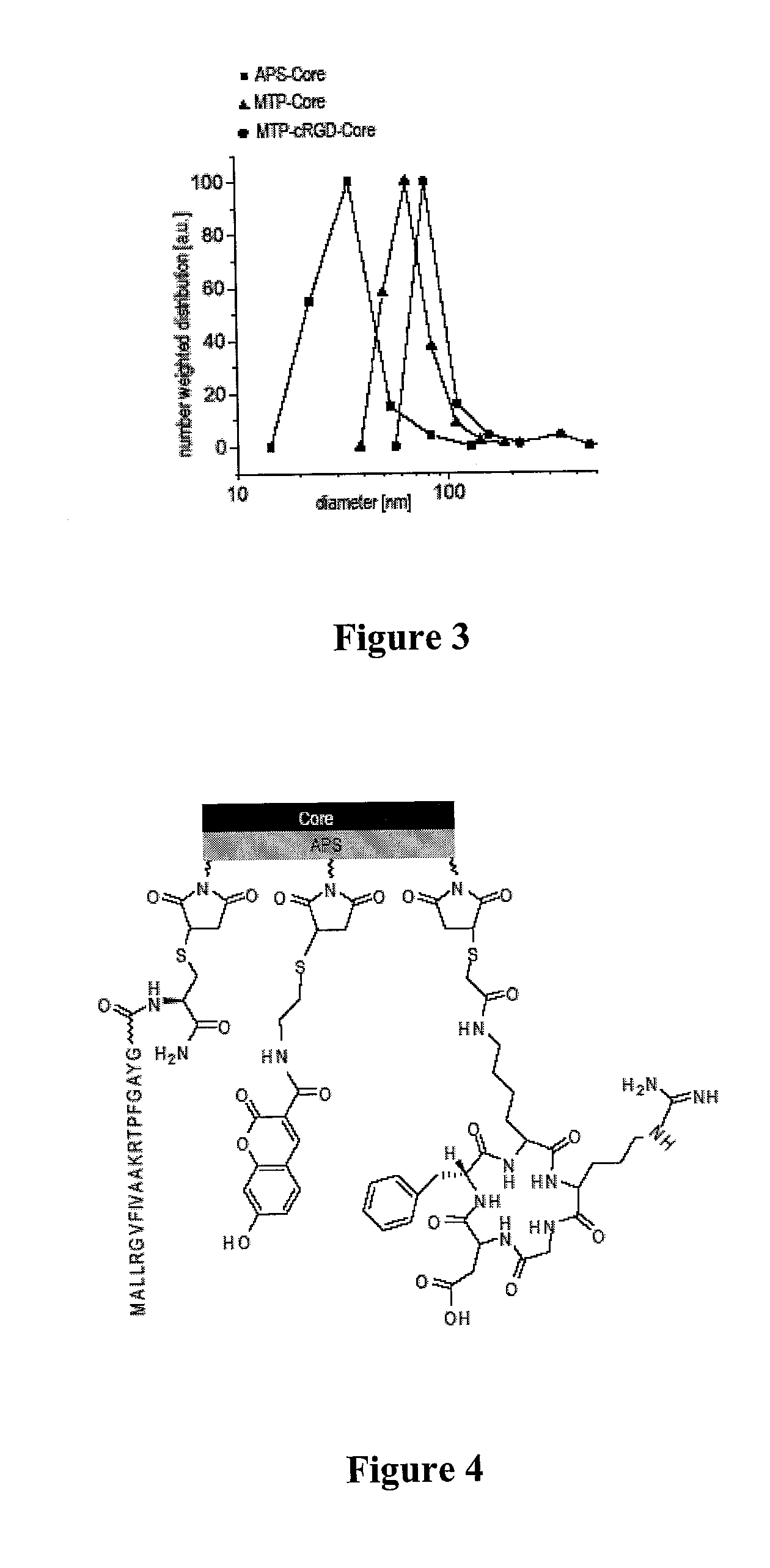Magnetic, paramagnetic and/or superparamagnetic nanoparticles
a superparamagnetic nanoparticle and paramagnetic technology, applied in the direction of magnetic materials, depsipeptides, powder delivery, etc., can solve the problems of inability to target within cells, laborious methods for identifying and isolating interaction partners of cellular components, and inability to achieve endocytosis of nanoparticles surrounded by membranes
- Summary
- Abstract
- Description
- Claims
- Application Information
AI Technical Summary
Benefits of technology
Problems solved by technology
Method used
Image
Examples
example 1
Preparation of Cores of Superparamagnetic Iron Oxide Nanoparticles
[0095]Superparamagnetic iron oxide nanoparticles are prepared by alkaline co-precipitation of ferric and ferrous chlorides in aqueous solution as described by Chastellain M. et al., J Colloid Interface Sci 278, 353-360, 2004. The obtained black precipitate is washed several times with ultra-pure water and the remaining solid refluxed in nitric acid (10−2 M) in the presence of iron-(III)-nitrate. The obtained brown suspension is dialyzed against 0.01 M nitric acid for two days, and stored at 4° C.
[0096]The iron oxide nanoparticle cores were characterized thoroughly by X-ray diffraction (XRD), surface area measurements (BET), transmission electron microscopy (TEM), photon correlation spectroscopy (PCS), and magnetic measurements (MM). The results are summarized in Table 1.
TABLE 1Average particle size of bare iron oxide nanoparticlesobtained by different methodsMethodSize [nm]XRD average volume weighted size10 ± 1 BET av...
example 2
Preparation of APS Coated Nanoparticles
[0097]The paramagnetic nanoparticle cores obtained in Example 1 were provided with an aminopropyltriethoxysilane (APS) coating as described by Steitz et al., 2007 Bioconjugate Chemistry DOI:10.1021 / bc070100v.
[0098]In brief, superparamagnetic iron oxide nanoparticles were coated with 3-(aminopropyl)triethoxysilane (APS) via a sonochemical route. 400 μL ferrofluid (from concentrations ranging from 12 mg to 0.6 mg iron / mL) were added to 9.6 mL ethanol in a 50 mL polystyrene vessel. Subsequently 1.5 mL aqueous ammonia (volume fraction 25%) and 1 mL APS were added and the mixture was continuously sonicated for 1 h in an ultrasound horn (Ultrasons Annemasse, Sonimasse S20). The reaction was carried out at a molar ratio of 1:35:15 APS / ethanol / H20. After sonication the sample was centrifuged at 30,000 g for 25 minutes (Jouan, GR2022). The supernatant was discarded and the pellet was re-suspended in ultrapure water. This process was repeated three times...
example 3
Synthesis of Targeting Peptides and Preparation of Thiolated Fluorophores
[0099]For the fabrication of the nuclear and mitochondrial targeting peptides with the corresponding sequences PKKKRKVGC and MALLRGVFIVAAKRTPFGAYGC, the protected amino acid derivatives were used (Novabiochem). The NovaSyn TGR resin (loading: 0.23 mmol / g), was used as the solid phase support. All solvents were dried over molecular sieves 3A (Fluka). Peptide syntheses were performed using a PSW1100 peptide synthesizer (Chemspeed AG) according to the instructions of the manufacturer. After completion, the resin was recovered and the cleavage was carried out with trifluoroacetic acid (TFA) / triisopropylsilane(TIS) / H2O (94:5:1) for four hours at room temperature with shaking. The peptide was precipitated directly from the cleavage cocktail into cold diethyl ether (800 ml), collected using a filter, dried under vacuum, and stored at −20° C. The peptide was dissolved in 0.1% TFA in water just prior to purification. Fl...
PUM
| Property | Measurement | Unit |
|---|---|---|
| Diameter | aaaaa | aaaaa |
| Nanoscale particle size | aaaaa | aaaaa |
| Fraction | aaaaa | aaaaa |
Abstract
Description
Claims
Application Information
 Login to View More
Login to View More - R&D
- Intellectual Property
- Life Sciences
- Materials
- Tech Scout
- Unparalleled Data Quality
- Higher Quality Content
- 60% Fewer Hallucinations
Browse by: Latest US Patents, China's latest patents, Technical Efficacy Thesaurus, Application Domain, Technology Topic, Popular Technical Reports.
© 2025 PatSnap. All rights reserved.Legal|Privacy policy|Modern Slavery Act Transparency Statement|Sitemap|About US| Contact US: help@patsnap.com



